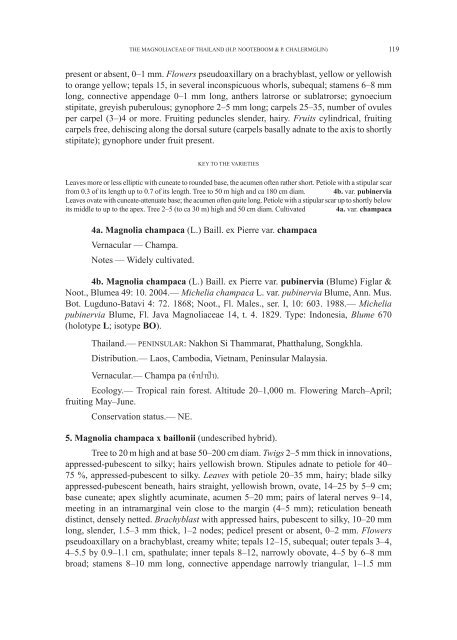You also want an ePaper? Increase the reach of your titles
YUMPU automatically turns print PDFs into web optimized ePapers that Google loves.
THE MAGNOLIACEAE OF <strong>THAI</strong>LAND (H.P. NOOTEBOOM & P. CHALERMGLIN)<br />
present or absent, 0–1 mm. Flowers pseudoaxillary on a brachyblast, yellow or yellowish<br />
to orange yellow; tepals 15, in several inconspicuous whorls, subequal; stamens 6–8 mm<br />
long, connective appendage 0–1 mm long, anthers latrorse or sublatrorse; gynoecium<br />
stipitate, greyish puberulous; gynophore 2–5 mm long; carpels 25–35, number of ovules<br />
per carpel (3–)4 or more. Fruiting peduncles slender, hairy. Fruits cylindrical, fruiting<br />
carpels free, dehiscing along the dorsal suture (carpels basally adnate to the axis to shortly<br />
stipitate); gynophore under fruit present.<br />
KEY TO THE VARIETIES<br />
Leaves more or less elliptic with cuneate to rounded base, the acumen often rather short. Petiole with a stipular scar<br />
from 0.3 of its length up to 0.7 of its length. Tree to 50 m high and ca 180 cm diam. 4b. var. pubinervia<br />
Leaves ovate with cuneate-attenuate base; the acumen often quite long. Petiole with a stipular scar up to shortly below<br />
its middle to up to the apex. Tree 2–5 (to ca 30 m) high and 50 cm diam. Cultivated 4a. var. champaca<br />
4a. Magnolia champaca (L.) Baill. ex Pierre var. champaca<br />
Vernacular — Champa.<br />
Notes — Widely cultivated.<br />
4b. Magnolia champaca (L.) Baill. ex Pierre var. pubinervia (Blume) Figlar &<br />
Noot., Blumea 49: 10. 2004.— Michelia champaca L. var. pubinervia Blume, Ann. Mus.<br />
Bot. Lugduno-Batavi 4: 72. 1868; Noot., Fl. Males., ser. I, 10: 603. 1988.— Michelia<br />
pubinervia Blume, Fl. Java Magnoliaceae 14, t. 4. 1829. Type: Indonesia, Blume 670<br />
(holotype L; isotype BO).<br />
Thailand.— PENINSULAR: Nakhon Si Thammarat, Phatthalung, Songkhla.<br />
Distribution.— Laos, Cambodia, Vietnam, Peninsular Malaysia.<br />
Vernacular.— Champa pa (จำปาป่ า).<br />
Ecology.— Tropical rain forest. Altitude 20–1,000 m. Flowering March–April;<br />
fruiting May–June.<br />
Conservation status.— NE.<br />
5. Magnolia champaca x baillonii (undescribed hybrid).<br />
Tree to 20 m high and at base 50–200 cm diam. Twigs 2–5 mm thick in innovations,<br />
appressed-pubescent to silky; hairs yellowish brown. Stipules adnate to petiole for 40–<br />
75 %, appressed-pubescent to silky. Leaves with petiole 20–35 mm, hairy; blade silky<br />
appressed-pubescent beneath, hairs straight, yellowish brown, ovate, 14–25 by 5–9 cm;<br />
base cuneate; apex slightly acuminate, acumen 5–20 mm; pairs of lateral nerves 9–14,<br />
meeting in an intramarginal vein close to the margin (4–5 mm); reticulation beneath<br />
distinct, densely netted. Brachyblast with appressed hairs, pubescent to silky, 10–20 mm<br />
long, slender, 1.5–3 mm thick, 1–2 nodes; pedicel present or absent, 0–2 mm. Flowers<br />
pseudoaxillary on a brachyblast, creamy white; tepals 12–15, subequal; outer tepals 3–4,<br />
4–5.5 by 0.9–1.1 cm, spathulate; inner tepals 8–12, narrowly obovate, 4–5 by 6–8 mm<br />
broad; stamens 8–10 mm long, connective appendage narrowly triangular, 1–1.5 mm<br />
119
















